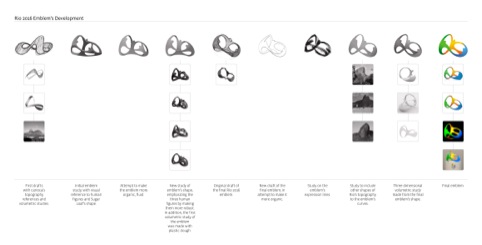Fred Gelli on creating the Rio 2016 Olympic and Paralympic branding
Tátil is the Brazilian design consultancy behind the branding for the Rio 2016 Olympic and Paralympic Games. We speak to creative director Fred Gelli about his sculptural logo forms, why it’s important to bring brands to life and where he finds his inspiration.

Design Week: Where do you find inspiration?
Fred Gelli: Nature has been my source of inspiration since I was 19 years old. All the time, nature is trying to do more with less and I think that’s the way the world needs to go.
There’s a very famous Brazilian designer called Aloísio Magalhães who died 20 years ago. He designed some of our most emblematic logos, and our currency, in very simple, clean and direct forms, and was very inspiring for me.
DW: What do you think are the current trends in logo design?
FG: The design of logos is going in two directions – either becoming more sensory, with movement, 3D forms and sounds, or being completely cleaned up. I like both, but the better solution is the most appropriate solution for the situation. Nowadays, everybody wants to have simple logos – but that’s just fashion, It’s superficial.
When the International Olympic Committee saw our Paralympic logo which uses sound and movement, they wanted us to do this for the Olympic logo too – but to use sound for the Olympic logo wouldn’t have been appropriate. I try to find the most natural solution. The best logos are the ones which connect deeply with the soul of the business. We try to materialise this, and recreate the ideas through expressions and symbols.

DW: How do you bring a logo to life?
FG: We live in a digital world where logos mostly appear on screens. With this idea that “everything must be flat”, you can lose the capacity to convey personality, because you’re using less resources. It’s much more complicated to design a very simple logo, than a complex logo. I think that providing direct information is really important. Take away everything extra, and keep only what is necessary. Also remember than an identity is more than just a logo – it’s an attitude. This is much more subtle and complex, but getting this right will also help with brand recognition. Brands must be authentic in their relationship with people, and create an experience. That’s much more important than a graphic symbol.
DW: How did you discover what the soul of the Olympic and Paralympic branding is?
FG: Before the expression, we look at brand direction. That’s our compass. One of our methods was conducting loads of interviews, and incorporating design thinking into our process – you don’t design for someone, you design with someone. We try to delve deep into the universe of our clients. Our work is just to materialise the meanings and ideas that already exist of that brand. I don’t draw a single line on a piece of paper without an idea behind it.
The Olympic and Paralympic logos are living brands. When you put something in the world, you are not its owner. Its relationship with other people is the most interesting part. You discover new meanings that you didn’t imagine in your design process.
DW: How do you get around the sensitivities of creating a Paralympic logo, and make it accessible for people with disabilities?

FG: This was our first challenge. All the Paralympic logos before ours were flat and not 3D. There are so many blind athletes, and these people who have connected with a sport their entire life need to experience that identity. I decided to create something that could be experienced by everyone. We used a heart icon – because everybody has a heart. We wanted to use things that people had in common, rather than things that make us different.
Something really special happened in the creative process when we invited some partially sighted people to give their opinions on the sculptural logo. One of them touched the logo, and asked what the hole was on top, where the ellipses symbol was. That was something we couldn’t see, but he could, and was totally reactive. We decided to flip the symbol, solving the problem of the hole and giving us the infinite symbol we ended up with. This was exactly what we wanted to represent from the beginning – this infinite energy.
DW: How did this idea carry over to the Olympic logo?

FG: We used the same strategy for the Olympic logo, by using archetypes and symbols that could be understood by everyone. The icon of people in a big hug – it’s so simple and has good associations of inspiration and people coming together.
DW: What would be your dream project to work on?
FG: I’d like to work for people and brands who really believe that they can change the world. This is part of my personal purpose. Each brand can be a protagonist to create a better future. For example, we worked with Natura, one of the biggest, eco-friendly cosmetics companies in Brazil. This is something that really makes a difference. I’d like to work with brands which are connected with our future, not our past.
DW: Do you have any advice for young designers?
FG: To understand that design or branding is much more than just creating beautiful stuff. It’s also much more than claiming prizes. Think about how to connect with the soul of a brand, and about originality and what makes it unique from the beginning. That is much more important than following fashion. The result is part of the process – you don’t need to search for it, it will come. It’s a little bit of a romantic view.
-
Post a comment




